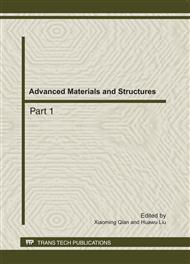[1]
O'Regan B and Grätzel M.: Nature, Vol. 353(1991), p.737.
Google Scholar
[2]
Grätzel M.: Nature, Vol. 414(2001), p.338.
Google Scholar
[3]
Easwaramoorthi Ramasamy, Won Jae Lee, Dong Yoon Lee, Jae Sung Song: Journal of Power Sources, Vol. 165(2007), p.446.
Google Scholar
[4]
W.J. Lee, E. Ramasamy, D.Y. Lee and J.S. Song: J. Photochem. Photobiol. A: Chem., Vol. 183(2006), p.133.
Google Scholar
[5]
Katsuhiro Onozuka, Bin Ding, Yosuke Tsuge, Takayuki Naka, Michiyo Yamazaki, Shinichiro Sugi, Shingo Ohno, Masato Yoshikawa and Seimei Shiratori: Nanotechnology, Vol. 17(2006), p.1026.
DOI: 10.1088/0957-4484/17/4/030
Google Scholar
[6]
Dan Li and Younan Xia: Nano letters, Vol. 3(2003), p.555.
Google Scholar
[7]
Remant Bahadur K.C. a, Chul Ki Kim b, Myung Seob Khil, Hak Yong Kim , and Ick Soo Kim: Materials Science and Engineering C, Vol. 28(2008), p.70.
Google Scholar
[8]
H. G. Duan, E. Q. Xie, J. G. Zhao, and C. W. Jia: Materials Science And Technology, Vol. 24(2008), p.241.
Google Scholar
[9]
A. Kumar,R. Jose, K. Fujihara, J. Wang, and S. Ramakrishna: Chem. Mater., Vol. 19(2007), p.6536.
Google Scholar
[10]
Jie Pan, Douglas W. Coffin, Lei L. Kerr: Photovoltaic Specialists Conference, PVSC '08. 33rd IEEE(2008).
Google Scholar
[11]
X. D. Li, H. B. Zhu, J. B. Chu, D. W. Zhang, Z. Sun and S. M. Huang: 3rd Shanghai International Nanotechnology Cooperation Symposium, Vol. 1(2007), p.135.
Google Scholar
[12]
K. Kalyanasundaran and M. Grätzel: Coord. Chem. Rev., Vol. 77(1999), p.347.
Google Scholar
[13]
B.Y. Lee, S.H. Park, S.C. Lee, M. Kang, C.H. Park and S.J. Choung: J. Ind. Eng. Chem., Vol. 42 ( 2003), p.812
Google Scholar
[14]
T.V. Vorburger, J.A. Dagata, G. Wilkening and K. Lizuka In: Czanderna et al., Editors, Beam Effects, Characterization of Surface Topography, and Beam Effects Depth Profiling in Surface Analysis, Plenum Press, New York; (1998).
DOI: 10.1007/0-306-46914-6_4
Google Scholar
[15]
H.T. Sun, Z. Li, J. Zhou, Y.Y. Zhao and M. Lu: Appl. Surf. Sci., Vol. 253(2007), p.6109.
Google Scholar
[16]
Seong Mu Jo, Mi Yeon Song, Young Rack Ahn, Chong Rae Park, Dong Young Kim: Journal of Macromolecular Science, Part A: Chemistry, Vol. 42(2005), p.1529.
DOI: 10.1080/10601320500229103
Google Scholar
[17]
W.U. Huynh, J.J. Dittmer and A.P. Alivisatos: Science, Vol. 295(2002), p.2425.
Google Scholar
[18]
M. Y. Song, D. K. Kim, K. J. Ihn, S. M. Jo, D. Y. Kim: Synthetic Metals;, Vol. 153(2005), p.77.
Google Scholar



